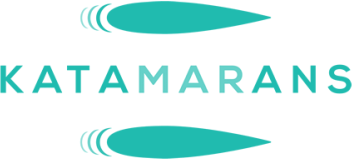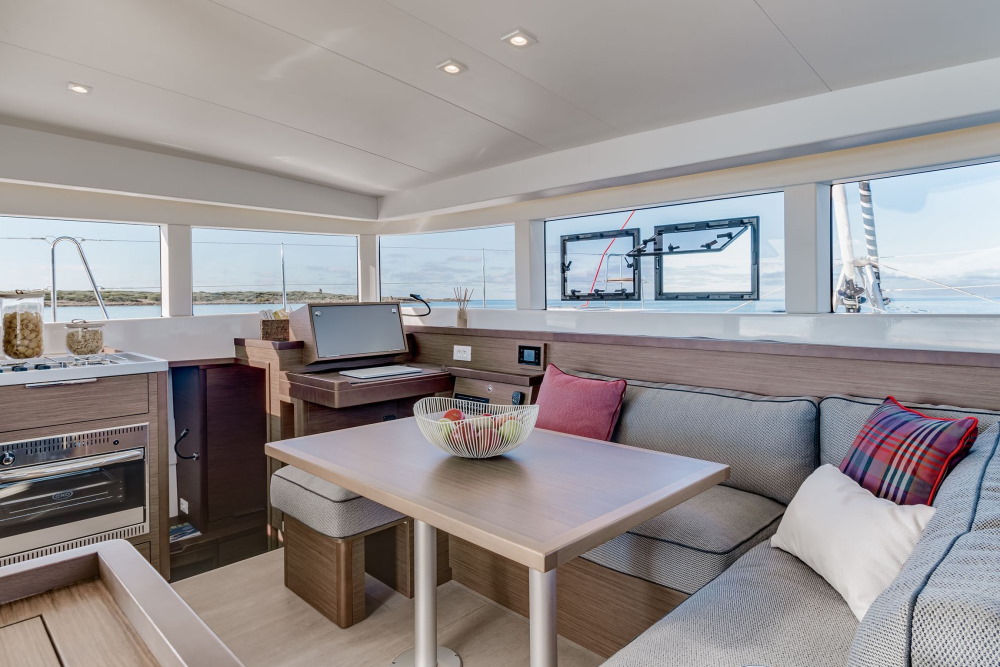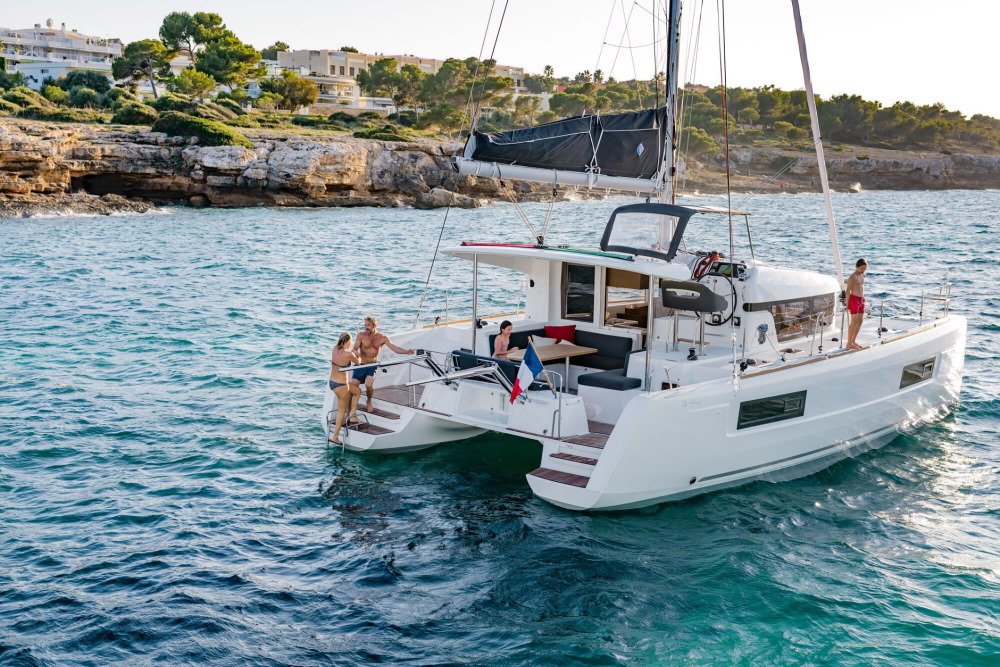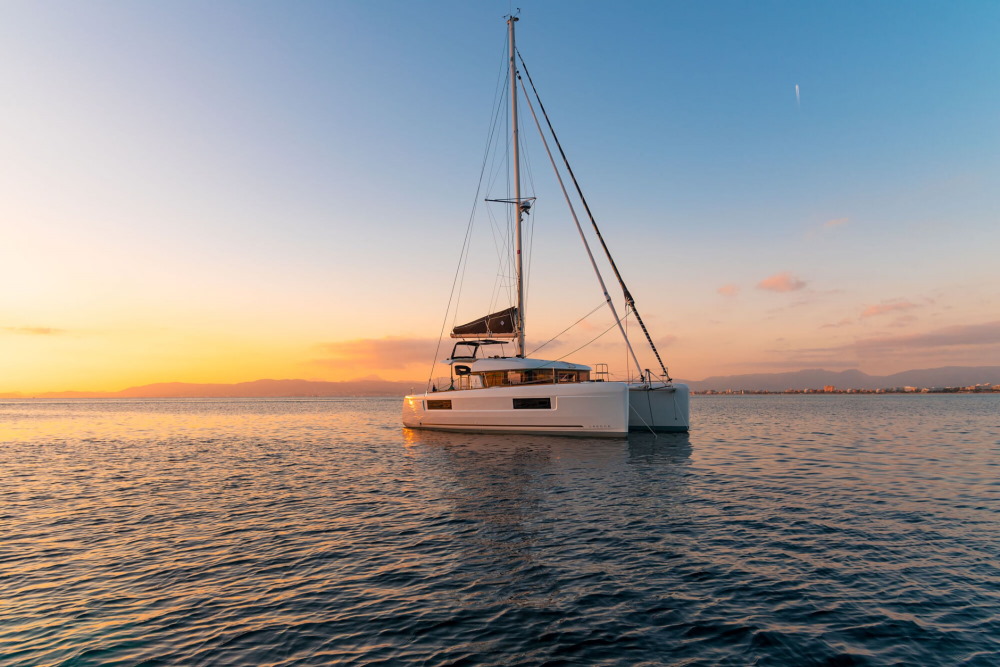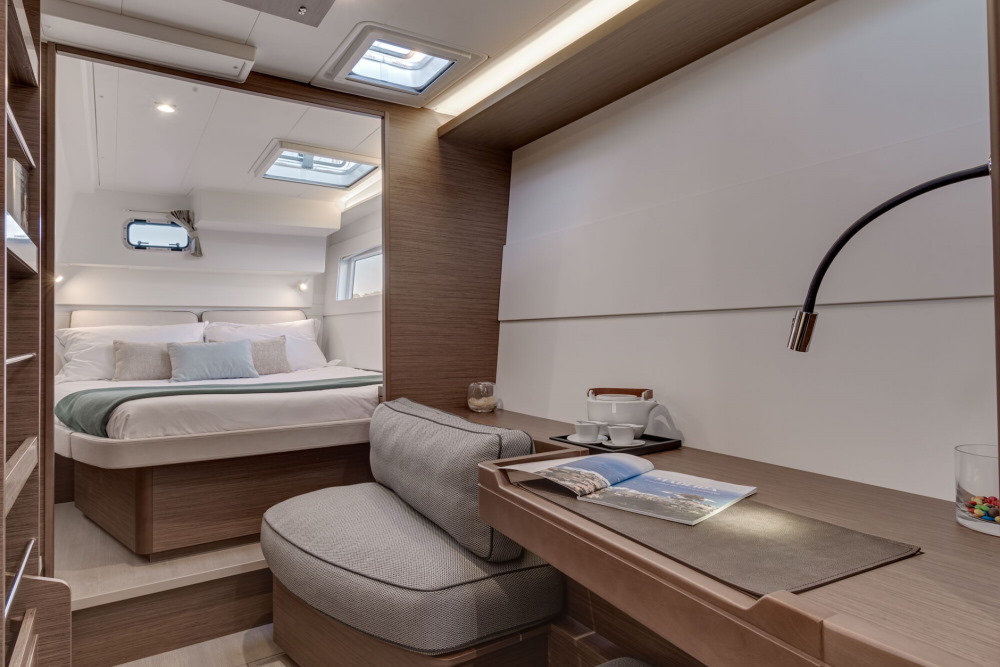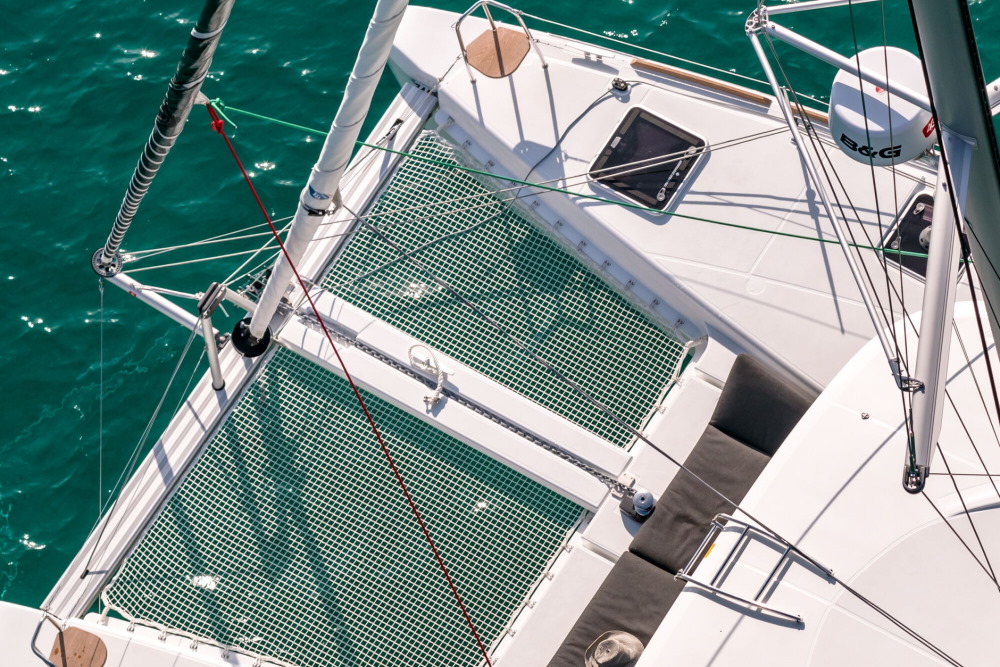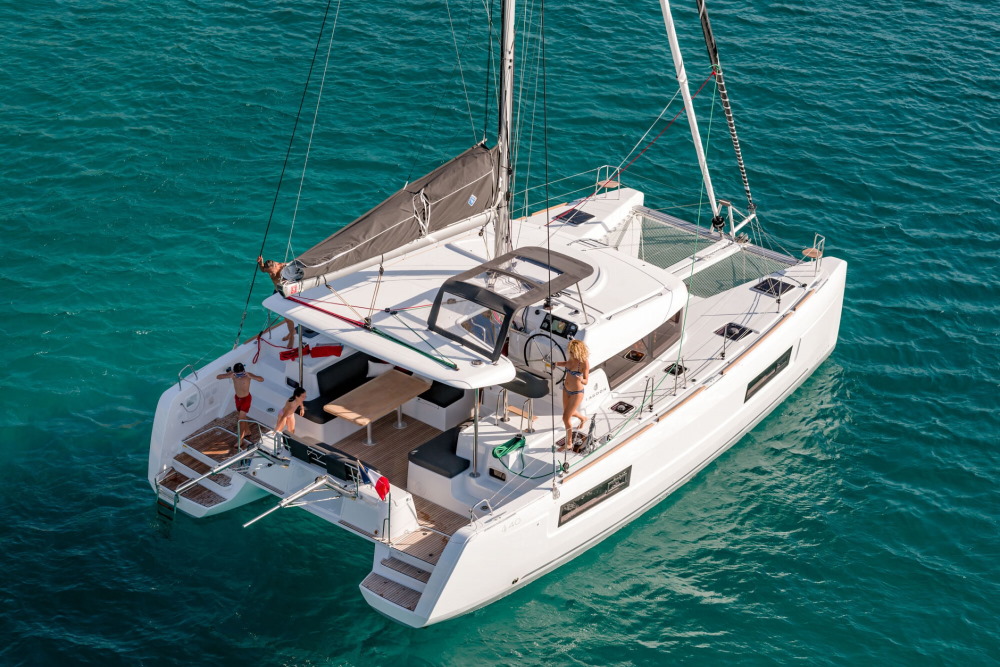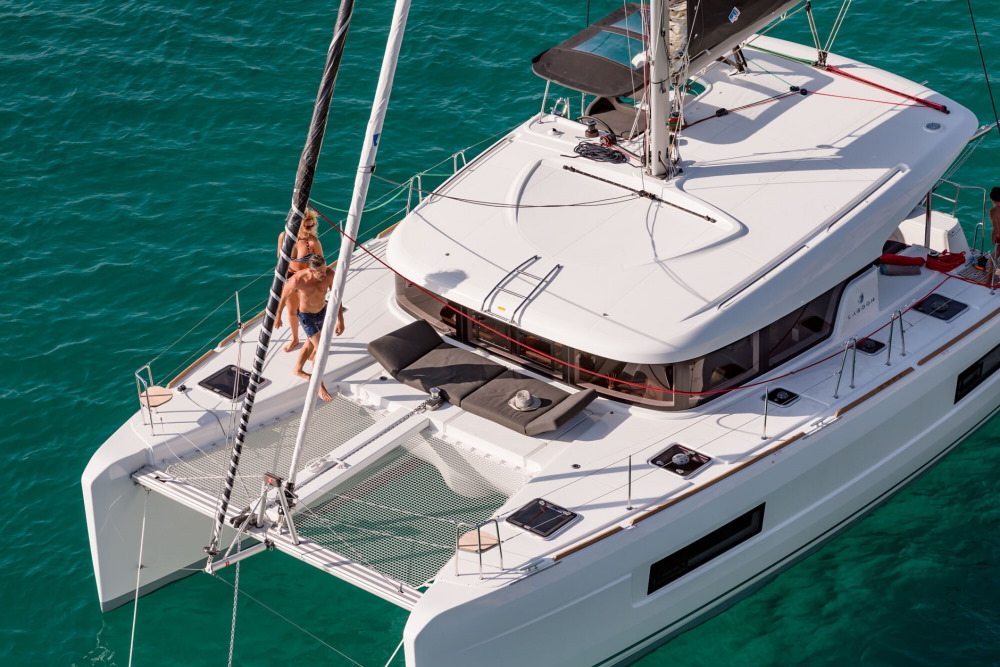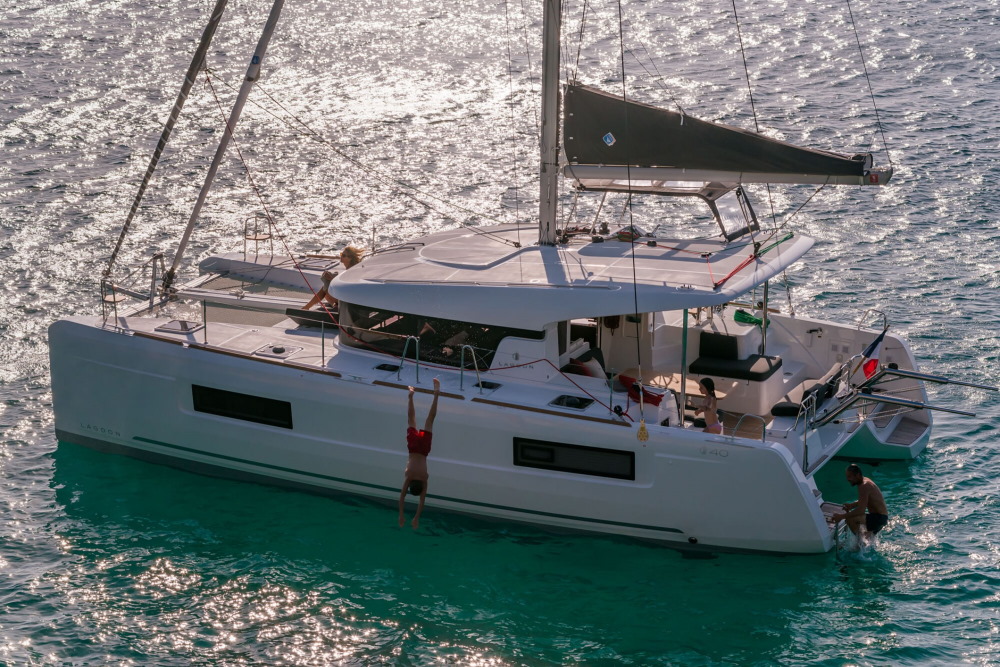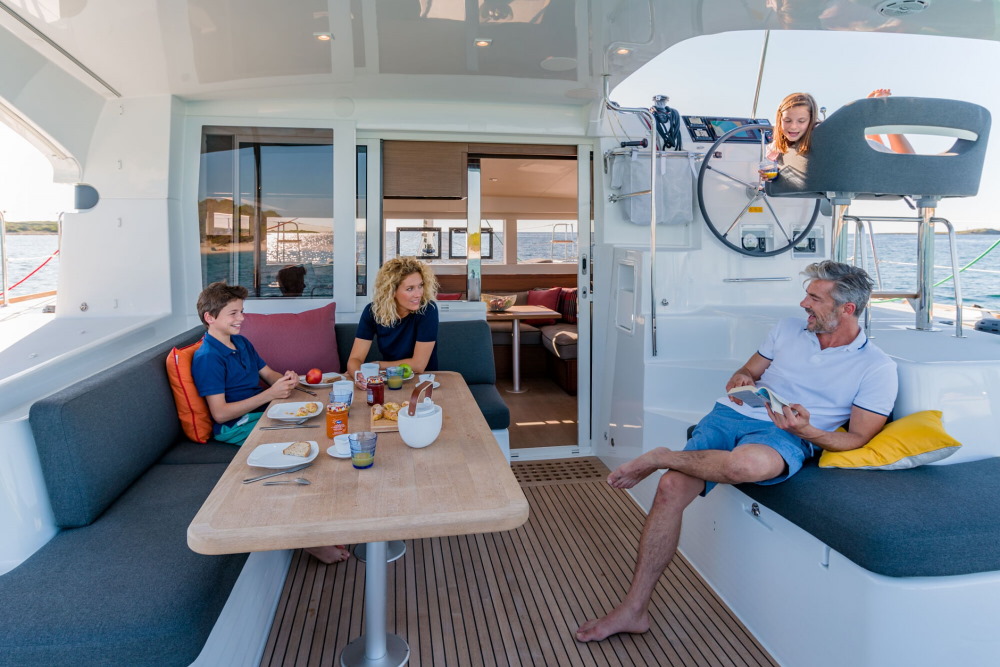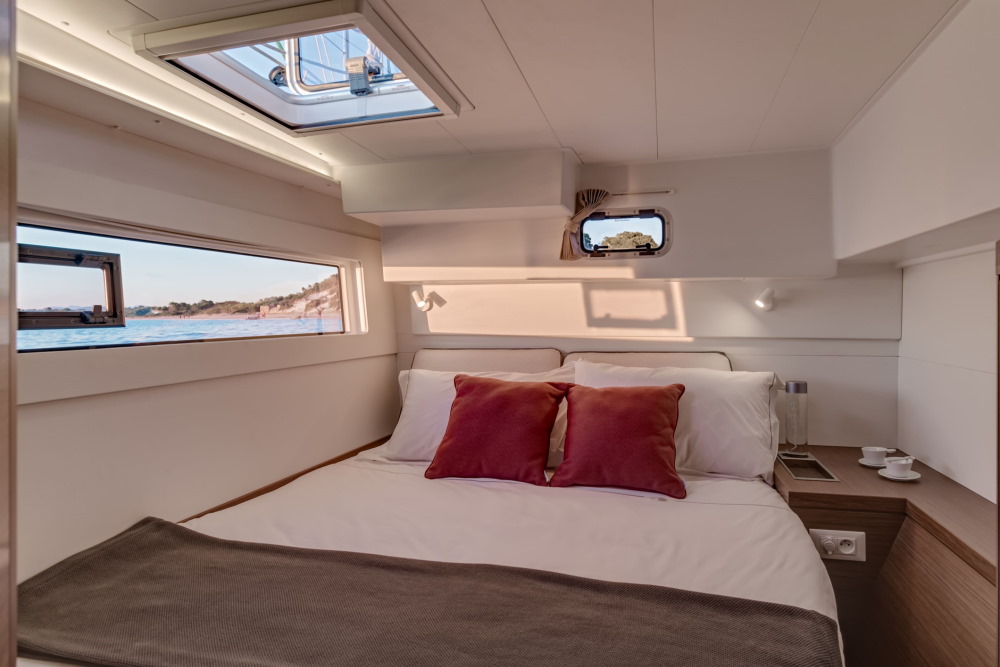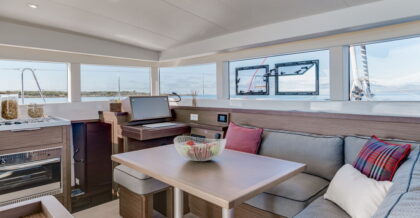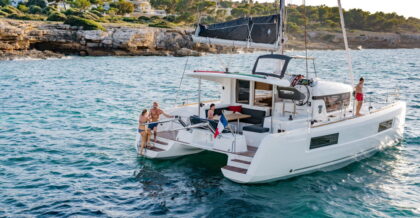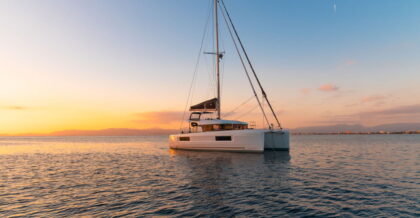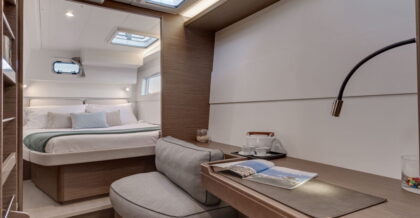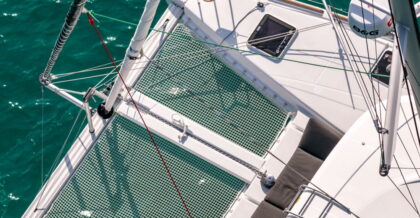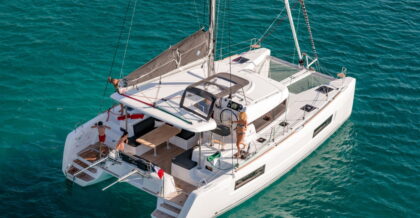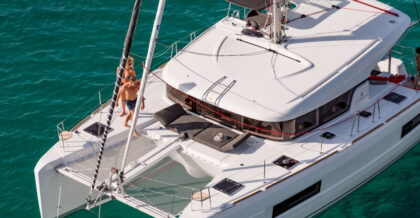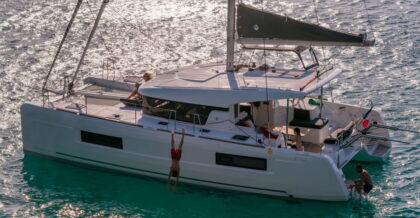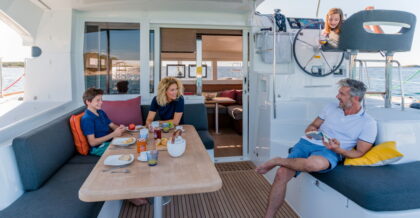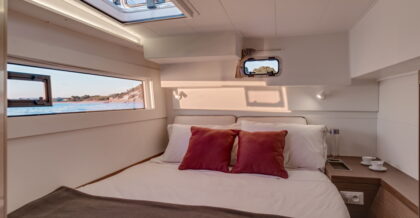The Lagoon 40 is the entry level catamaran for the famous French catamaran manufacturer now that they have stopped producing the 39, the 400 S2 and the iconic 380. The 40 is almost 800kg lighter than the 39- that will give you an idea of how Lagoon had adjusted the dial on this boat. The mast is further back than the 400 in the new Fourth Gen style and it is wider.
A Big Seller
Will the 40 hit the kinds of sales that the 380 achieved? You wouldn’t bet against it, this looks like it will become one of the best selling Lagoon catamarans of all time. It will have to catch the 42 though. These days, of course, they have a lot of competition from the likes of Fountaine Pajot, Leopard and even sister company Excess.
Photos credit: Nicolas Claris.
 1 Minute Summary
1 Minute Summary
– The 40 is 800Kg lighter than the 39.
– The mast has been moved further back compared to the 400 (easier sail handling).
– Visibility is pretty good to all 4 corners, the port bow being the hardest to see.
– Down below there’s plenty of space. She’s the best in class here.
– Put the square top mainsail down as one one of your priority options.
– She sails OK upwind for a fixed keel cruising cat, don’t pinch her too high.
– Upgrade to the 45HP Yanmars if you can.
Charter a Lagoon 40 Catamaran
Are you looking for a Lagoon 40 to charter?
Browse our selection of high quality yachts for rent below ⇓
Rent a Lagoon 40
Find Lagoon Catamarans for charter.
All | Lagoon |
Full review, specs and video below (5 minute read)
Overall Design
Designed by long term Lagoon partners VPLP, the 40 has taken many of the design cues from her older and larger fourth generation sisters (especially the successful 42): a more angular, muscly look, bigger windows and portholes for more light. The saloon windows are still vertical, that trademark Lagoon look, but they have been stretched which gives the boat a streamlined look.
4th Gen Styling with the Mast Further Aft
With a vacuum-infusion construction and balsa coring in the deck and the hull above the waterline, the weight has been kept off as much as possible. The mast is well aft in the new 4th Gen style, with an easy to handle main and bigger foresail- all good stuff for sailing her short handed.
Pros
- The accommodation is the roomiest in her class, although Fountaine Pajot probably matches her with the Isla 40.
- She feels safe to clamber about – there are plenty of handrails to grab onto and most of the hatches are recessed on deck
- The Lagoon 40 is well set up for short-handed or even single handed sailing with that mast aft, big headsail configuration.
- She is surprisingly good upwind and great fun off the wind (especially with the larger headsail up in 18 knots of wind).
- Lagoon is a popular brand. If their previous models are anything to go by, there should be demand for your boat when it is time to sell.
Cons
- The Square Top main is an option. This should be first on your list in my opinion or you’ll risk feeling underpowered under sail, especially in lighter winds.
- Because the bimini stops short of the aft bench and that bulkhead helm, the aft cockpit will get wet quickly in a downpour.
- The saloon / aft cockpit area doesn’t feel as open as many of her competitors, especially with that mast support stepped so far back. It feels a bit like you have to weave your way into the saloon compared to more open designs like some of the Nautitech catamarans we have taken a look at.
- There is no ventilation in the roof in the saloon – this could get hot and stuffy quickly with the burners on.
- The folding ladder that you use to get onto the coachroof from the foredeck could be sturdier
- At 300L, the fresh water storage is on the low size compared to the competition.
On Deck
2 steps take you up from the sugar-scoops to the aft cockpit where they have added an aft beam seat and a dining table with an L-Shaped wrap around sofa. The bulkhead helm peeps up over the bimini on the starboard side in traditional Lagoon Sport Top fashion, and there´s a day lounger tucked in behind it on the starboard side.
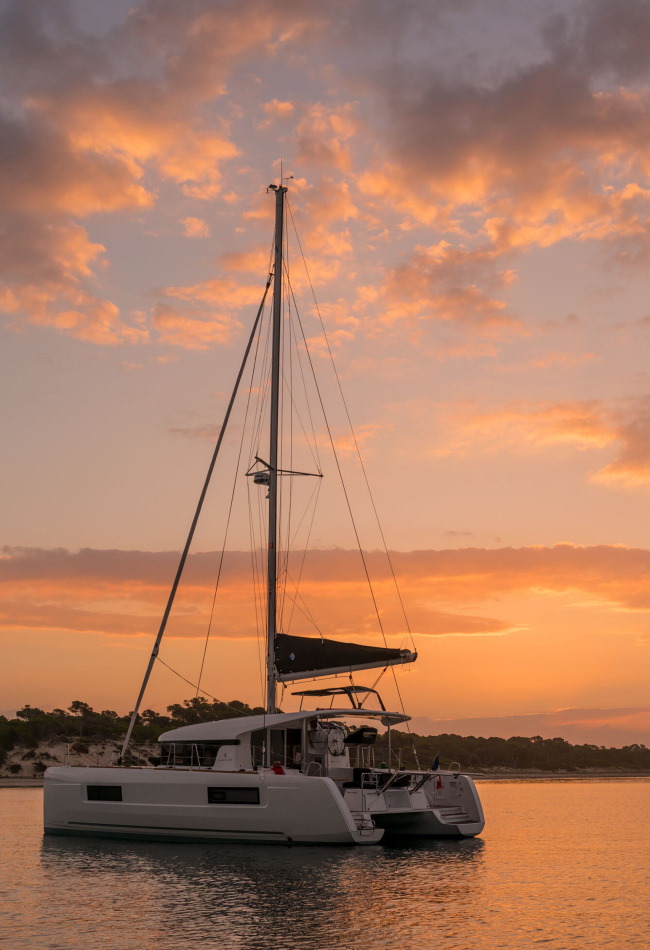 Bulkhead Helm
Bulkhead Helm
On the starboard side, steps lead up to the bulkhead helm from the cockpit, so that you are well connected to the crew and with a bit of ducking and diving you can see all four corners of the boat from here, the port bow being the most difficult.
You´ll need to step up to see the bows though which makes it more difficult to reach the throttles. Coming in stern first when docking is the way to go, just duck under the bimini for the best visibility and at 38 and a half foot, she is very manoeuvrable with those twin engines (29HP or 40HP on the upgrade).
Getting up onto the bimini and to the mast is pretty easy- either jump up from the helm, or head up via the ladder from the foredeck. Most of the deck hatches are recessed on the deck (apart from the forepeaks).
Decent Visibility, Well Connected
Overall, the helm position is a great compromise. You are connected to the cockpit, visibility is OK, and the mast is still low enough to access quickly and easily if you need to sort problems out with any lines.
The downside with these single bulk head helms is that it’s not so easy to trim your sails on both tacks. The genoa is problematic on the port tack. Also, if it´s raining hard, your aft cockpit is going to get wet quickly unless you get your helm covers up quickly, there is not as much protection as you get on cats with a full bimini.
The other thing with the 40, is that the bimini does not extend back to the aft of the boat. That gives you a view of the mainsail from the aft bench but again, that means there is less protection from the sun and rain at the back of the boat.
Down Below
Well, this is where Lagoon excels, isn’t it? With fatter hulls than much of the competition, there is more room down here for accommodation and the 40 feels like a much bigger boat than 38 and a half feet.
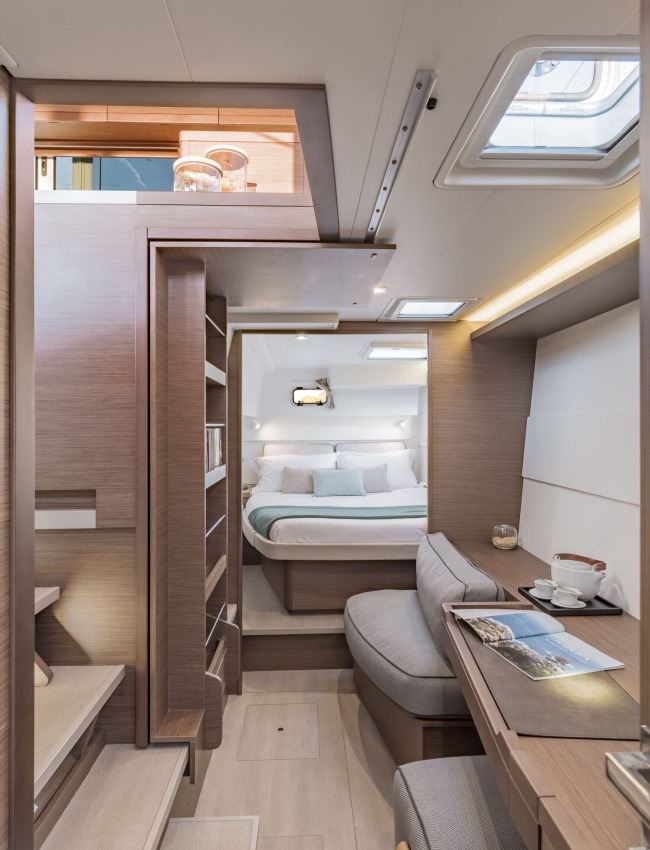 Best in Class Down Below?
Best in Class Down Below?
The finish feels pretty luxurious for an entry level boat- Lagoon has definitely upped their game from their 380 days. Time will tell how the interior wears, but it looks good.
The saloon and galley layout is pretty standard- why change a winning formula? There’s an aft facing galley on the port side (with only a single sink though). Forward is an ample wrap around sofa, the dining table and a nav desk tucked into the forward port corner.
To starboard aft is a refrigerator/freezer and plenty of storage. Ventilation comes from 2 forward hatches. They could do with some hatches in the roof in my opinion, I say that about most of the Lagoons. It would be cooler and you could keep an eye on the mainsail.
Three or Four Cabins
Your options are three to four cabins and two to four heads. In the maestro version, the whole port hull is given over to the master suite, and it feels big. Forward is the head with a large shower , and aft is an island berth. Amidships, there’s an office space with a desk and sofa, and a sliding door to keep any pesky guests out. With those bigger port windows, it’s nice and light down here.
In the other hull to starboard, there are two guest cabins that share a head with a shower (or you can go for 2 smaller heads). If you really want to pack ’em in, you can configure the boat with 4 berths and 4 heads, but I’d go 4 berths and 2 or 3 heads or 3 berths and 2 or 3 heads.
Sailing
It´s worth going for the square-top mainsail option on the 40, as this will catch the clean air up high and will move the Lagoon nicely in a breeze. Like most of the range, she won´t get going quickly in light airs, but once the wind fills in, this catamaran will move nicely, especially on a beam reach with the Code 0 up (go for the bowsprit option if you can). In a moderate to fresh force 4/5 you should see double digit speeds off the wind and respectable speeds (8 knots) pointing higher up to 50 degrees apparent.
Acceptable Upwind Performance
Sailing upwind, you will probably be doing 110 degree tacks. Pinch her any further and the speed drops off and you will start to slip sideways, but that is true of many cruising cats. If you need to get up wind fast, fire up the leeward engine to give you a boost.
The standard sail area is 875ft with a self-tacking jib with sheets that lead back to a track on the coach roof just forward of the mast. This frees up the foredeck for a sunlounger cushion just aft of the nets.
She’s an easy boat to handle short-handed. All lines come back to the helm (apart from the furling lines for the headsails and the gennaker sheets). Make sure you go for the folding props- that should give you an extra knot.
Engines On
The standard engine set up is twin 29HP Yanmars with saildrives, but I would recommend the upgrade to 2x 45HP to help you power through the chop. There is minimal weight penalty. The 40 will motor along happily at over 7 knots at 2,300 rpm and you should see 6 knots with just one engine running if you want to conserve diesel. The engine rooms are nice and roomy for maintenance – we have no complaints on that front.
Summary
The Lagoon 40 has every chance of match the 380’s sales number as long as they don’t launch another entry level boat any time soon.
The Market Leader
There is stiff competition in this sector of the market, with Fountaine Pajot launching the Isla 40 (bit nippier, feels less robust), the Nautitech 40 Open (more performance, less space down below) and the Bali 4.1 (higher boom, more living space), but I would guess that the Lagoon is the top seller.
The charter companies have lapped this boat up and they remain very popular with owner operators too. It should definitely be on your short list.
FAQs
How does the Lagoon 40 compare to the 400S2 and the 380?
In terms of size, the 40 sits in between these 2 boats. With the mast stepped back, in general the Sail Area to Displacement ratios are lower for the newer Lagoons. In light winds, the game is all about getting the Code 0 up. The 410 is substantially longer and packs more sail power for its weight than the others.
How much does a new Lagoon 40 cost?
The price is heavily dependent on the options you go for, but €500-550k gets you in the ball park for a new boat (ex taxes).
Technical Specification
| Draft | Draft: 1.35 m / 4’ 5” |
|---|---|
| D/L | 16.6 |
| SA/D | 17.4 |
| Water | Water: 300L / 80 US gal |
| Fuel | 2 x 200L / 53 US gal |
| Sail Area | 80 m2/ 861 sq ft |
| Engines | 2x29 HP or 45HP Yanmars |
| Length | 11.74 m / 38’ 6” |
| Beam | Beam: 6.76 / 22’ 2” |
| Code 0 | 63 m2 / 678 sq ft |
| SA/D* | 17.4 |
| Jib | 32 m2 / 344 sq ft |
| Mainsail (Sq Top) | 48 m2 / 516 sq ft |
| Displ. | 10.9 tonnes / 24,000 lbs |
Contact Katamarans
Share your details with us and we’ll be in touch to discuss further.
"*" indicates required fields
